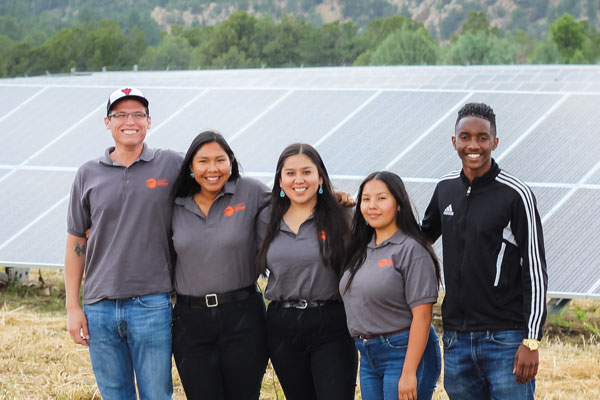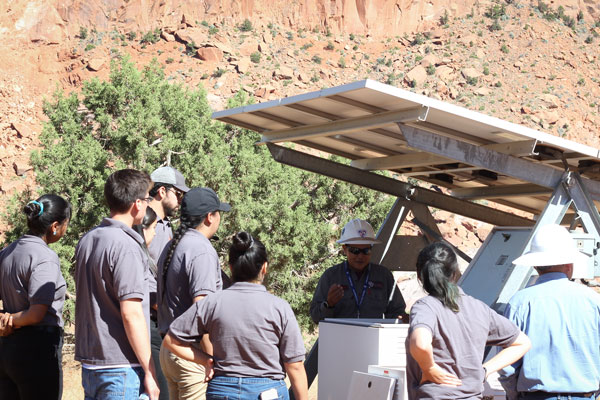Indian Energy Internship Program Q&A with Sherralyn Sneezer

Sherralyn Sneezer is one of four students who interned at Sandia this summer through the DOE Indian Energy Internship Program. As we observe Native American Heritage Month this November, the Lab News spoke with Sherry about her experience at Sandia and her plans for the future. Sherry has a bachelor’s degree in environmental studies with honors from Dartmouth College, and is from the Navajo Nation.
What was the program like?
We went on several field visits to the Navajo Nation, the Laguna Pueblo and the Acoma Pueblo. We also visited the Mescalero Apache and the Picuris Pueblo, which were both beautiful places. The program allowed us to talk face-to-face with tribal professionals working in energy development, as well as learn about the relationship between utilities and tribal nations, especially regarding energy development on tribal lands.
Even though I’m from the Navajo Nation, I have not had the opportunity to talk with renewable energy specialists from the Navajo Tribal Utility Authority, and it was an important discussion that allowed me to glimpse into the present and future of renewable energy development on the Navajo Nation. I was able to critically think about what is needed to pursue further renewable energy development, so that I could better understand where I am needed in this pursuit.
There were four Indian Energy interns this year: two from the Navajo Nation, one from Acoma Pueblo and one from the Spirit Lake Band of Chippewa. Additionally, three other Native American interns in the U.S. Department of the Interior Minority Serving Institutions Program tagged along on field visits with us. They were Brett Alberts, Isnala Nanjin RoanEagle and Roy Rafael. These guys were an integral part of our field visits and internship program at Sandia. It has been interesting to learn about each other’s cultures. Before this internship, I didn’t know much about the different pueblos even though I grew up in Arizona. However, we were all able to bond over our love for our tribal nations and renewable energy development to empower our tribal communities.
What was your project?
I created multiple maps to illustrate the potential locations for solar photovoltaic energy development at the utility scale on the Navajo Nation. These maps were based off previous studies done by the National Renewable Energy Laboratory, but I made them specifically for the Navajo Nation, as opposed to all tribal lands like NREL’s studies.
Since the Navajo Nation has different land issues, culturally sensitive areas and grazing permits, it has made it difficult to determine the best-suited sites for utility-scale solar energy development. Once I made the maps and determined the total area of the potential sites, I used the methodology from NREL’s previous studies to calculate the estimated energy capacity and generation if utility-scale solar PV fields were developed at each of these sites.

What was working with the mentors like?
The mentors are great, and they have been instrumental in the success of this internship program. Each mentor brought a unique aspect to the program through their different personalities and personal experiences, but they all made sure that the interns had all the tools needed to complete our research projects. Furthermore, they have been more than willing to assist us with our academic and career goals.
I’m applying to graduate schools right now, and the mentors have been very helpful in discussing how I can prepare, as well as what could help me accomplish my goals in the future, especially working with renewable energy on the Navajo Nation. It was truly a pleasure to get know the mentors and learn about the adversity they overcame to become successful at Sandia.
What is one of your main take-aways from this internship?
The biggest thing about this program was being able to talk with Sandia staff about their personal challenges and how they overcame those challenges. From their experiences, I found hope that I will also be able to overcome my challenges. I was under the impression that the journey from education to a career had to be a straight line in order to be successful, if that makes sense. I imagined life happening in a particular order: bachelor’s, master’s, doctorate, a successful career and then family. In my thought process, there was no time between those steps – just a continuous cycle without any breaks until all the stages had been completed. While I listened to my mentors, I realized that their journeys were not a straight line like I had imagined, yet they persisted.
It was good to hear about their personal experiences and journeys – it has been uplifting to me. There is sometimes a feeling that you don’t belong in a certain place, like at Dartmouth or Sandia. It’s a voice that says, “you’re not smart enough” or “you’re not an engineer” or “you only got in because you’re Native American.” We may hear it from other people, too, but we must persist. That voice does not build me up – only I can build myself up. I am passionate about helping my community, using renewable energy as a source to empower the Navajo Nation. I do have a place.
What would you like to do in the future?
For graduate school, I am very interested in the advanced energy systems master’s program at the Colorado School of Mines or the energy master’s at Texas A&M. My goal overall is to go back to the Navajo Nation and help with renewable energy development as a way to empower Navajo people. It’s been a very coal-dependent economy for the past 50 years, and one of the generating stations is closing at the end of this year. I’m interested in how to mitigate those effects on the Navajo Nation and people through the use of renewable energy.